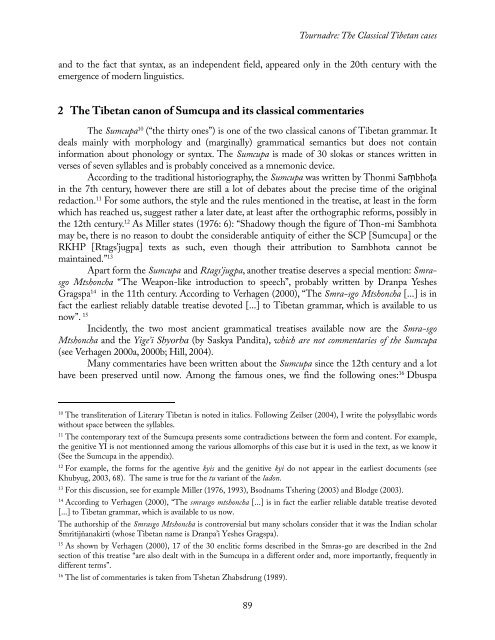The Classical Tibetan cases and their transcategoriality
The Classical Tibetan cases and their transcategoriality
The Classical Tibetan cases and their transcategoriality
Create successful ePaper yourself
Turn your PDF publications into a flip-book with our unique Google optimized e-Paper software.
89<br />
Tournadre: <strong>The</strong> <strong>Classical</strong> <strong>Tibetan</strong> <strong>cases</strong><br />
<strong>and</strong> to the fact that syntax, as an independent field, appeared only in the 20th century with the<br />
emergence of modern linguistics.<br />
2 <strong>The</strong> <strong>Tibetan</strong> canon of Sumcupa <strong>and</strong> its classical commentaries<br />
<strong>The</strong> Sumcupa 10 (“the thirty ones”) is one of the two classical canons of <strong>Tibetan</strong> grammar. It<br />
deals mainly with morphology <strong>and</strong> (marginally) grammatical semantics but does not contain<br />
information about phonology or syntax. <strong>The</strong> Sumcupa is made of 30 slokas or stances written in<br />
verses of seven syllables <strong>and</strong> is probably conceived as a mnemonic device.<br />
According to the traditional historiography, the Sumcupa was written by Thonmi Saṃbhoṭa<br />
in the 7th century, however there are still a lot of debates about the precise time of the original<br />
redaction. 11 For some authors, the style <strong>and</strong> the rules mentioned in the treatise, at least in the form<br />
which has reached us, suggest rather a later date, at least after the orthographic reforms, possibly in<br />
the 12th century. 12 As Miller states (1976: 6): “Shadowy though the figure of Thon-mi Sambhota<br />
may be, there is no reason to doubt the considerable antiquity of either the SCP [Sumcupa] or the<br />
RKHP [Rtags’jugpa] texts as such, even though <strong>their</strong> attribution to Sambhota cannot be<br />
maintained.” 13<br />
Apart form the Sumcupa <strong>and</strong> Rtags’jugpa, another treatise deserves a special mention: Smrasgo<br />
Mtshoncha “<strong>The</strong> Weapon-like introduction to speech”, probably written by Dranpa Yeshes<br />
Gragspa 14 in the 11th century. According to Verhagen (2000), “<strong>The</strong> Smra-sgo Mtshoncha [...] is in<br />
fact the earliest reliably datable treatise devoted [...] to <strong>Tibetan</strong> grammar, which is available to us<br />
now”. 15<br />
Incidently, the two most ancient grammatical treatises available now are the Smra-sgo<br />
Mtshoncha <strong>and</strong> the Yige’i Sbyorba (by Saskya P<strong>and</strong>ita), which are not commentaries of the Sumcupa<br />
(see Verhagen 2000a, 2000b; Hill, 2004).<br />
Many commentaries have been written about the Sumcupa since the 12th century <strong>and</strong> a lot<br />
have been preserved until now. Among the famous ones, we find the following ones: 16 Dbuspa<br />
10 <strong>The</strong> transliteration of Literary <strong>Tibetan</strong> is noted in italics. Following Zeilser (2004), I write the polysyllabic words<br />
without space between the syllables.<br />
11 <strong>The</strong> contemporary text of the Sumcupa presents some contradictions between the form <strong>and</strong> content. For example,<br />
the genitive YI is not mentionned among the various allomorphs of this case but it is used in the text, as we know it<br />
(See the Sumcupa in the appendix).<br />
12 For example, the forms for the agentive kyis <strong>and</strong> the genitive kyi do not appear in the earliest documents (see<br />
Khubyug, 2003, 68). <strong>The</strong> same is true for the tu variant of the ladon.<br />
13 For this discussion, see for example Miller (1976, 1993), Bsodnams Tshering (2003) <strong>and</strong> Blodge (2003).<br />
14 According to Verhagen (2000), “<strong>The</strong> smrasgo mtshoncha [...] is in fact the earlier reliable datable treatise devoted<br />
[...] to <strong>Tibetan</strong> grammar, which is available to us now.<br />
<strong>The</strong> authorship of the Smrasgo Mtshoncha is controversial but many scholars consider that it was the Indian scholar<br />
Smritijñanakirti (whose <strong>Tibetan</strong> name is Dranpa’i Yeshes Gragspa).<br />
15 As shown by Verhagen (2000), 17 of the 30 enclitic forms described in the Smras-go are described in the 2nd<br />
section of this treatise “are also dealt with in the Sumcupa in a different order <strong>and</strong>, more importantly, frequently in<br />
different terms”.<br />
16 <strong>The</strong> list of commentaries is taken from Tshetan Zhabsdrung (1989).
















